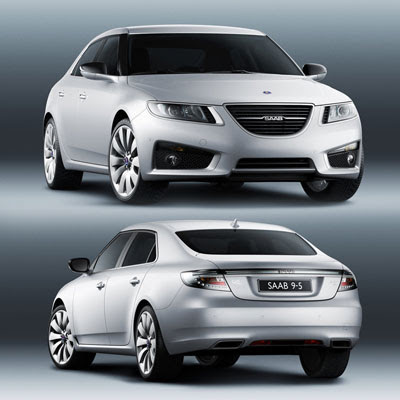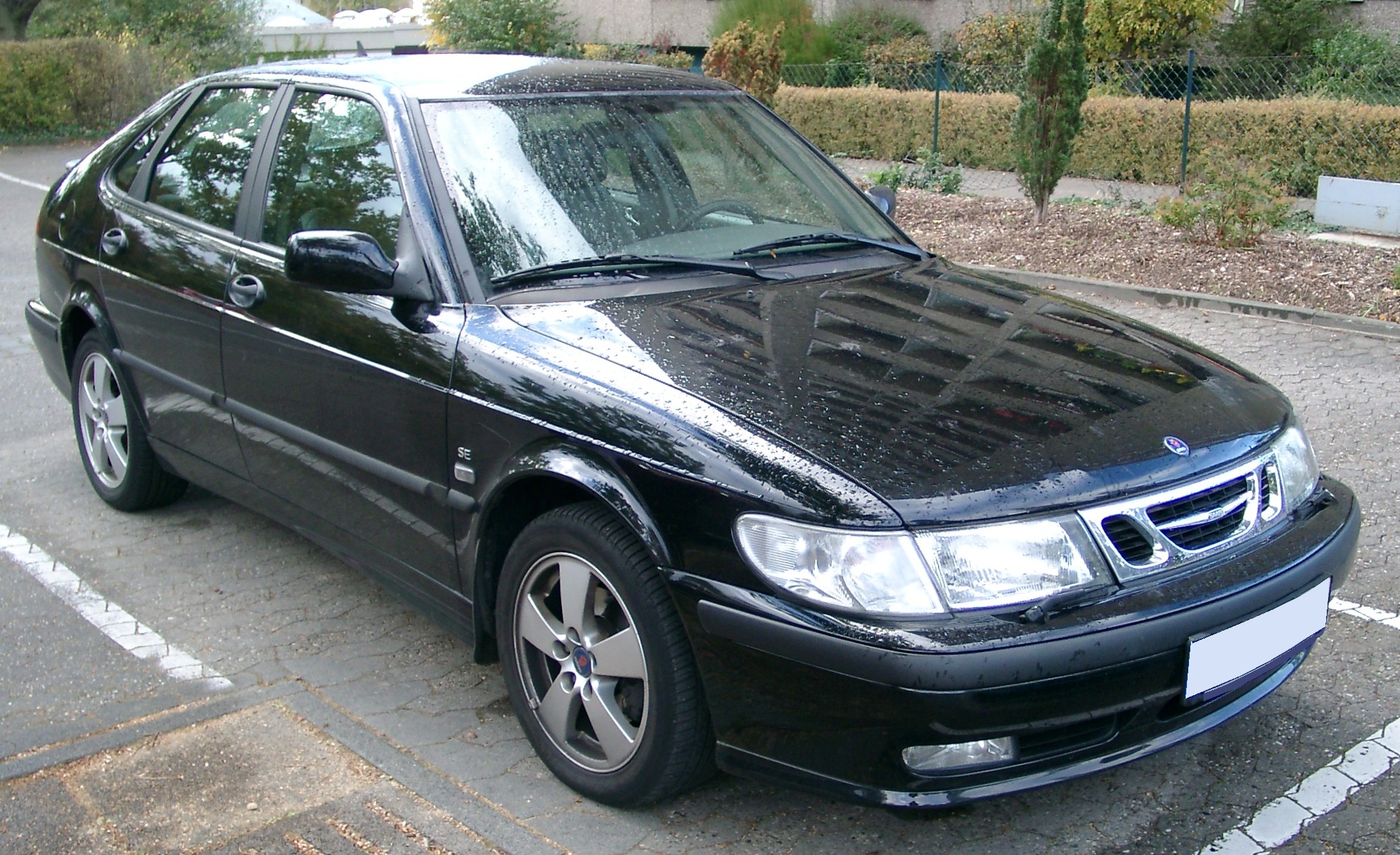 Saab Automobile AB, better known as Saab (English pronunciation: /ˈsɑːb/, or SAAB, an acronym for Svenska Aeroplan Aktiebolaget),is a Swedish car manufacturer owned by Dutch automobile manufacturer Swedish Automobile NV, formerly Spyker Cars NV.[7] It is the exclusive automobile Royal Warrant holder as appointed by the King of Sweden.[8] Originally the automobile manufacturing division of Svenska Aeroplan Aktiebolaget (English: Swedish Airplane Limited), later known as Saab AB, Saab Automobile was acquired by General Motors in 1990 who sold it to Spyker Cars N.V. in 2010.
Saab Automobile AB, better known as Saab (English pronunciation: /ˈsɑːb/, or SAAB, an acronym for Svenska Aeroplan Aktiebolaget),is a Swedish car manufacturer owned by Dutch automobile manufacturer Swedish Automobile NV, formerly Spyker Cars NV.[7] It is the exclusive automobile Royal Warrant holder as appointed by the King of Sweden.[8] Originally the automobile manufacturing division of Svenska Aeroplan Aktiebolaget (English: Swedish Airplane Limited), later known as Saab AB, Saab Automobile was acquired by General Motors in 1990 who sold it to Spyker Cars N.V. in 2010. In 1944, Project 92 began, with the goal of creating the first Saab passenger car. The result, the Saab 92001 (or Ursaab), was unveiled three years later, with a design that highlighted the company's roots in aviation. Notably, the car's drag coefficient of 0.30 was the lowest of any production car of the time.
In 1944, Project 92 began, with the goal of creating the first Saab passenger car. The result, the Saab 92001 (or Ursaab), was unveiled three years later, with a design that highlighted the company's roots in aviation. Notably, the car's drag coefficient of 0.30 was the lowest of any production car of the time.Three years into Project 92, a company site in Trollhättan was converted to allow automobile assembly and the project moved there. The company has remained headquartered there since.
In 1949, Saab was ready to bring the car to market, and the Saab 92 went into production, selling 20,000 examples through the mid-1950s.
 In 1969, Saab merged with the Swedish commercial vehicle manufacturer Scania-Vabis AB to form Saab-Scania AB.
In 1969, Saab merged with the Swedish commercial vehicle manufacturer Scania-Vabis AB to form Saab-Scania AB.The 99 range was expanded in 1973 with the addition of a combi coupe model, a body style which quickly became synonymous with Saab. Owing to its great success, the millionth Saab was produced in 1976.
Saab entered into an agreement with Fiat in 1978 to sell a rebadged Lancia Delta as the Saab 600 and jointly develop a new platform. The agreement yielded 1985's Saab 9000, sister to the Alfa Romeo 164, Fiat Croma and Lancia Thema; all rode atop a common Type Four chassis. The 9000 was Saab's first proper luxury car.
 GM's involvement spurred the launch of a new 900 in 1994. The new car shared a platform with the Opel Vectra. Due in large part to its success, Saab earned a profit in 1995 for the first time in seven years. However, the model never achieved the cult following of the "classic 900" and did not achieve the same reputation for quality.
GM's involvement spurred the launch of a new 900 in 1994. The new car shared a platform with the Opel Vectra. Due in large part to its success, Saab earned a profit in 1995 for the first time in seven years. However, the model never achieved the cult following of the "classic 900" and did not achieve the same reputation for quality.1997 marked Saab's 50th anniversary as an automaker. The company used their jubilee owner's convention to launch a replacement for the aging 9000: the Saab 9-5. The 900 received a facelift and renaming complimentary to its new larger sibling: it would now be called the Saab 9-3. The 9-5 was the first Saab without a combi coupe bodystyle option in twenty years. Filling that space was a wagon variant, introduced in 1999.
 A common feature of Saab car types is the use of the number 9 in the model numbers. Current models are the 9-3 and 9-5, both of which are manufactured in Trollhättan, Sweden. Until 2008, the 9-7X was manufactured by General Motors along with the Chevrolet Trailblazer and its platform-mates. The exception to this naming rule is the Saab-Lancia 600, which was a rebadged Lancia Delta.
A common feature of Saab car types is the use of the number 9 in the model numbers. Current models are the 9-3 and 9-5, both of which are manufactured in Trollhättan, Sweden. Until 2008, the 9-7X was manufactured by General Motors along with the Chevrolet Trailblazer and its platform-mates. The exception to this naming rule is the Saab-Lancia 600, which was a rebadged Lancia Delta. Safety has a high priority in the design of Saab cars. The cars are subjected to the Älgtest (elk test) as elk are a common cause of accidents in Sweden. Saab have compiled a database containing over 6,100 real-life accidents with Saabs. The first recorded event was in 1948 where Julian Shermis had an accident.
Safety has a high priority in the design of Saab cars. The cars are subjected to the Älgtest (elk test) as elk are a common cause of accidents in Sweden. Saab have compiled a database containing over 6,100 real-life accidents with Saabs. The first recorded event was in 1948 where Julian Shermis had an accident.All modern Saabs (except the 9000 and 9-2X) have a floor-mounted ignition. This is for many reasons, some of which follow:[citation needed] Saab believes this is a safer position in case of an accident. The driver's knee often jerks upward in a collision; the compact and dense ignition module on the steering column of many other cars has shattered many kneecaps. Saabs have bolstered dashboards for both front seat occupants. Also, the floor-mounted position yields more space, allowing modern Saabs to have a metal bar that rotates over and up into the ignition when the key is turned to the "Lock" position. This makes Saabs very challenging to hotwire. Ergonomically, the ignition's location next to the parking brake lever, gearshift, and seatbelt, saves time. Last of all, the ignition is located on the floor because, in the aircraft that inspired Saab automobiles, the throttle controls were all located on the floor. Originally Saabs also had the key located on the right side of the steering column, but when they changed from a column shifter to a floor shifter, the ignition key followed along, except in the Sonett III and 9000.
 Dating back to 1937, Svenska Aeroplan AB (SAAB) created airplanes, introducing their first car, the Saab 92001, in 1947. Currently, Saab AB is separate from Saab Automobile (which is owned by Swedish Automobile, formerly Spyker Cars), and is probably best known for its Saab 37 Viggen (the Viggen badge would be shared by a 9-3). This has led to a ad campaign, "Born From Jets", evoking the days when Saab produced both aircraft and automobiles. Saab is imported into many countries. Each company has a president to the subsidiary or importer. In the case of the U.S., the first president was Mr. R. Millet.
Dating back to 1937, Svenska Aeroplan AB (SAAB) created airplanes, introducing their first car, the Saab 92001, in 1947. Currently, Saab AB is separate from Saab Automobile (which is owned by Swedish Automobile, formerly Spyker Cars), and is probably best known for its Saab 37 Viggen (the Viggen badge would be shared by a 9-3). This has led to a ad campaign, "Born From Jets", evoking the days when Saab produced both aircraft and automobiles. Saab is imported into many countries. Each company has a president to the subsidiary or importer. In the case of the U.S., the first president was Mr. R. Millet.In 1987, Saab created a TV advertisement called "Saab suite" (subtitled Ballet in 3 acts for 8 Saab 9000 Turbos). In the film, stunt drivers show incredible driving with stock cars, such as one-wheeled burnouts, bumper-to-bumper driving through a slalom, cars slaloming from opposite directions on the same course, two-wheel driving, sliding in full speed, and jumping over passing cars—all on a closed airport runway with classical music playing in the background. Click Here to view the video.
 As the brand has an unusual image in most markets, Saab owners tend to be correspondingly offbeat: intellectuals and enthusiasts.In his studies of brand communities, Albert Muniz, professor of marketing at DePaul University in Chicago, found significant characteristics of Saab owners which he called Snaabery.These included ownership of an original, pre-GM Saab; camaraderie with other Saab drivers and contempt for other brands such as BMW. Writer John Crace characterised the typical "Snaab" as a creative advertising executive with large spectacles and an asymmetric hairstyle.Rüdiger Hossiep, a psychologist at Ruhr University Bochum, found that Saab drivers have the highest level of psychological involvement with their cars, being over 10 times more passionate than the average Volkswagen driver.Saab's main three markets are Sweden, the United Kingdom and the United States.
As the brand has an unusual image in most markets, Saab owners tend to be correspondingly offbeat: intellectuals and enthusiasts.In his studies of brand communities, Albert Muniz, professor of marketing at DePaul University in Chicago, found significant characteristics of Saab owners which he called Snaabery.These included ownership of an original, pre-GM Saab; camaraderie with other Saab drivers and contempt for other brands such as BMW. Writer John Crace characterised the typical "Snaab" as a creative advertising executive with large spectacles and an asymmetric hairstyle.Rüdiger Hossiep, a psychologist at Ruhr University Bochum, found that Saab drivers have the highest level of psychological involvement with their cars, being over 10 times more passionate than the average Volkswagen driver.Saab's main three markets are Sweden, the United Kingdom and the United States.
No comments:
Post a Comment